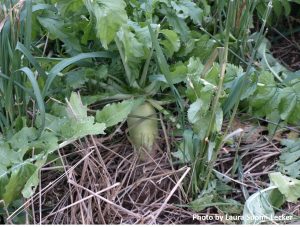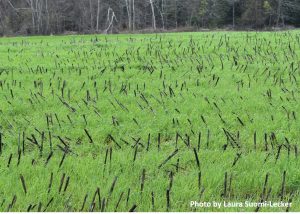Cover Crop and No-Till Management Case Study: Hewett Farm

Farmer: Tim Hewett
Location: Skowhegan, Maine
Farm Type: Cattle & forage
Size: 643 acres of cropland; additional woodland
Soil Type: Adams loamy sand at farmstead; cropland soil types vary
Crops: Silage corn, hay
Cover Crops: Tim has tried winter rye, winter triticale, and a mix of Italian rye, red clover, and tillage radish.
Partially No-till since: 2015
Weed Management: Roundup to kill sod/cover crop; Spring IPM scouting for other weed control needs. Varies by year.
Tim Hewett grew up on a dairy farm and has been running his own diversified farm in Skowhegan for 30 years, producing and selling hay, corn, cattle, compost, maple syrup and wood. He manages 643 acres of cropland, including roughly 210 acres in silage corn.
Tim is constantly re-defining his farming operation, with an eye to adding diversity and improving sustainability on his farm. He does a lot of reading and talking with other farmers and agricultural resource personnel from his Certified Crop Advisor to Cooperative Extension to NRCS. Once he has gathered his information, Tim looks for ways to integrate the new ideas on his farm. “You have to be open to trying new things. What I like about farming, is that you can always try to make it better, and that is what makes it interesting. If you can make it better after you make a mistake, then you are happy.” And, he adds with a laugh, “If you haven’t made a mistake, you haven’t tried!”
Tim put this principle to work with the USDA-Natural Resources Conservation Service Conservation Innovation Grant (CIG) Soil Health Project in the past three years. The CIG Soil Health Project provided financial and technical assistance to landowners in Kennebec, Somerset and Waldo Counties to innovatively add cover crops and reduce tillage on their farms. Prior to the program, Tim had been thinking about trying no-till planting and adding cover crops to his silage corn fields. He was the first farmer to sign up for the program in 2014, electing to do three split field trials for fall-sown winter cover crops. The split field trials were meant to test on-farm differences between winter cover and no cover in the same field on the same soil type, side by side. In 2015, Tim went on to try some no-till corn planting and purchased a no-till planter. He has been increasing his no-till acres each year since then. In 2016, he tried inter-seeding a pre-harvest cover crop in conjunction with his summer corn nitrogen application.
Unfortunately, results of the split field and the inter-seeding trials were less than encouraging. The winter cover crops across the board had minimal growth and coverage before winter snow. Despite this frustrating lack of success so far, Tim still firmly believes in the need for and benefits of winter cover.
Cover Crop Benefits

Tim is determined to make cover cropping a part of his crop management plan for two major reasons:
- Weed and erosion control: “I think both cover crops and no-till planting are the answers to the problems of weed control and erosion control”, he says. “[With corn planting], we are losing so much topsoil – on a windy day and in the rain, you can see it. You can’t put enough organic material down to replace what you are losing. And once it starts, every year it gets worse. But if you have a good hold on the soil with cover, then you are way ahead of the game.”
- Improving soil and water quality: Tim also feels cover crops are better for the health of his soil and for “the whole world”, in that they help keep soil and nutrients out of public waters. “I have grandkids, and I want them to have clean water. It is our job to leave it better than it was.” Tim also feels that this keeps farms ahead of environmental regulations.
Cover Cropping Methods
Timing: After trying both before and after harvest cover crop establishment, Tim feels that inter-seeding is the best method for his operation. A neighboring farmer buys and harvests Tim’s silage corn, and thus, Tim has less control over when the corn is harvested. Because it is generally not harvested until October, Tim finds it difficult to have success with fall-sown winter cover crops.
Given the less-than-successful inter-seeding trial with nitrogen applications, Tim’s next plan is to try aerial seeding, providing the cost is manageable. This way, he feels that he will have the most flexibility to get the cover crop seeded at optimal corn growth stage and weather conditions without disturbing his corn crop.
Termination: As for killing the crop in the spring, Tim has used Roundup (glyphosate) with success. He suggests: “Don’t let [the cover crop] get more than 12 inches tall and try to kill the cover crop a couple of weeks ahead of your projected planting date. Let it start breaking down a little, then go in and plant.”

Species: Through the course of the CIG project, Tim tried fall plantings of winter rye and triticale in 2014 and 2015. Both crops were lightly harrowed in after planting. Unfortunately, again due to a late corn harvest, he felt that neither species got enough growth in the fall to get the full benefits of the cover. Though he felt that he did receive some benefit from both plantings in the spring, it just wasn’t cost effective.
This was particularly frustrating with the triticale, since it provided an additional source of palatable feed for the cattle. “I need to get the corn off by middle of September to do it”, Tim says, “But if I harvested my own corn, I would absolutely do the triticale again! It worked great to chop and feed that out in May and then go right in and no-till plant corn.” He adds that for anyone thinking of planting triticale, it is best sown in non-rocky, sandy soil, so you can mow it easily.
For the inter-seeding that Tim tried with nitrogen applications, he used a mix of Italian rye, clover, and tillage radish. Going forward, Tim is open to trying new cover crop species, singly or in mixes. He adds, “I am looking for ones that are good for wildlife, birds and deer.” Tim feels that wildlife, perhaps hunting or bird-watching, could be another service provided by the farm, and an additional benefit of the cover crop seeding.
Cover Cropping Challenges
- Corn harvest timing is Tim’s biggest challenge to getting a cover crop established. Therefore, Tim feels that inter-seeding is his best management option.
- Corn herbicide protocol: Tim feels that his greatest challenge for successful inter-seeding of cover crop is the compatibility and timing of the herbicides used for the corn with the cover crop planting. This was another lesson Tim had to learn the hard way. His inter-seeding trials in 2016 were failures, likely due to the timing and type of herbicide that was used on the corn.
- Cover crop seed availability and source: Tim says that he has found quite a difference in seed prices and seed quality. He says the best thing to do is “book it early, check your prices, and get clean seed.” He feels that it is important to buy certified seed whenever possible, to avoid “getting a bunch of weed seeds” in the bargain.
The No-Till Journey

Tim purchased his no-till planter in 2015. He now does about half of his corn ground as no-till. As part of the CIG project, Tim hosted a no-till planter tune-up workshop at his farm, using his planter as the demo. Though he has had some challenges, he feels that no-till is an important piece of the future of his farm.
No-Till Benefits
- Fuel and time savings: “I think with the price of fuel, you have to go no-till…also for the time savings.”
- Weed control: No-till in combination with cover crops is a key to weed suppression. Not tilling the soil and having a cover crop on the field prevents the weeds from having a chance to germinate. Over time, this reduces weed pressure in the corn. “It takes a few years, but then you can come out ahead.“
- Healthier crops: “I am committed to doing no-till and crop rotation now to have better corn and grass crops. [With no till] you are compacting your ground less, your topsoil isn’t running off, and that means healthier plants.”

Hewett no-till planter with Rico Balzano from University of Vermont Extension - Equipment life-span: Tim says rocks encountered while plowing are hard on the harrows, and that means frequent replacement. No-till means less equipment maintenance and longer equipment life.
- Crop rotation becomes easier to add to field management: This is another piece of having better soil and better crops. It works well to no-till corn into former sod ground. Tim’s goal is to get his corn ground into a three or four year rotation.
No-Till Challenges
- Changing old habits: Tim’s journey from conventional to no-till management has been a slow transition, requiring the changing of long-ingrained habits and getting past the years of “being told that we need to harrow and plow” to help the soil warm in the spring. But Tim is content to take it slow. He says if you listen to folks who have done long-term no-till, they will tell you it is going to take a few years to get the benefits. “You aren’t going to see the changes to your soil overnight.”
- No-till planter adjustments: Tim has found that some of his no-till corn stands have been “skippy”. He feels that he still doesn’t have his planter settings quite right, despite trial and error, including making some adjustments, only to find that he needs to adjust things back the other way. He adds that the key to learning the best planter settings is to try to find another farmer with a similar planter and talk with them. “You can’t know everything, so the key is finding the right people to help you.”
Is there an overall economic benefit to cover cropping and no-till? Tim thinks for a moment, then says, “Maybe a little. When you get things set right, you can probably save money. The real benefit is in time savings and the quality of ‘everything’. I would like to not harrow a bit of ground!” When asked what will help him achieve that goal, Tim gives another of his infectious laughs and says, “Luck!”
Finally: Advice to new cover crop and no-till adopters: “Talk with everyone you can. Some people say it is all easy, but it isn’t. You need to make mistakes, then you learn from them. But if you can find people to help you, that will save you making some mistakes. Also, it is important to start small and try one piece at a time.”
Writing and photos by Laura Suomi-Lecker, Technical Director, Somerset County Soil and Water Conservation District, Skowhegan, Maine.
Posted January 2018.
This piece was written as part of a series of Soil Health case studies, supported in part by Northeast SARE, project SNE15-07.
